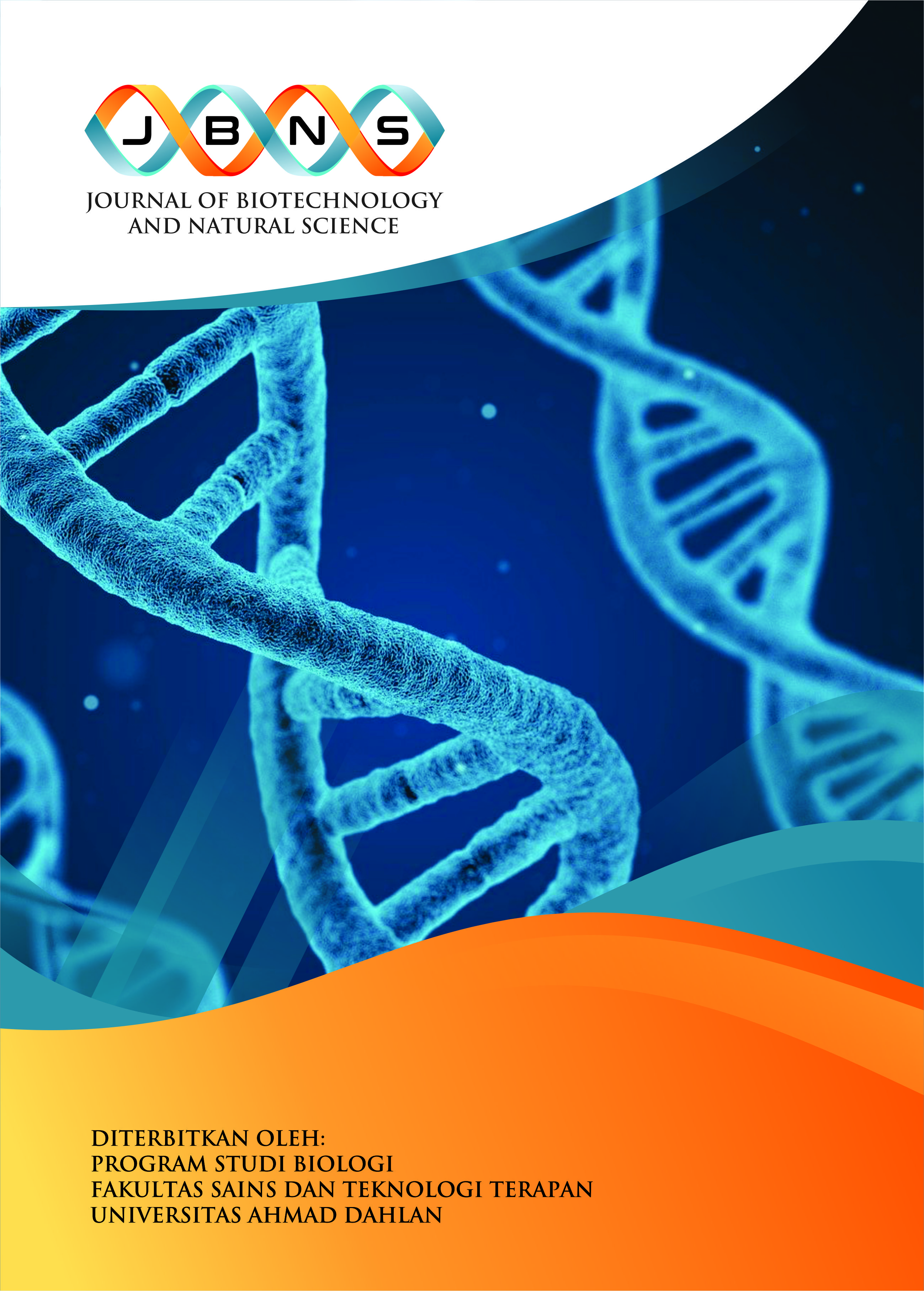Inventory Of Predatory Insects In Banana Germplasm Umbulharjo Yogyakarta
DOI:
https://doi.org/10.12928/jbns.v1i1.4733Keywords:
Inventory, Paratrechina longicornis, Pitfall trap, Predatory, SweepnetAbstract
One of the beneficial insects in agriculture and plantations is a predator. Using natural predators to control pests and diseases certainly has advantages. The purpose of this study was to calculate the level of predatory insect diversity in banana germplasm plantations and find the most abundant and least abundant predatory insects. The independent variable in this study is the banana germplasm plantation area, and the dependent variable in this study is the diversity and dominance of predatory insects found in the research location. Sampling in this study using a random method. The sweep net was in the morning, while the pitfall was collected, installed in the morning and taken in the afternoon. Predatory insect data analysis used in this study is to use the scan now-wiener diversity index and the Simpson dormancy index. The results showed that the predatory insects that mainly were found were the species, Paratrechina longicornis while the least that was found was the species Ischiodon scutellaris. From other results, namely the level of predatory insect diversity obtained, the results show that Yogyakarta banan germ plantation have moderate diversity of predatory insects. The conclusion of this study is that there is a disturbance in the Giwangan Banana Germplasm Garden Yogyakarta due to insects, so that the diversity index is moderate, while the predominance of predatory insects is 0.484, which means that in the ecosystem, one predatory insect is found that dominates.
References
Abrams, PA. (2000). The evolution of predator-prey interactions: Theory and evidence. Annual
Review of Ecology and Systematics, 31, 79-105. doi: 10.1146/annurev.ecolsys.31.1.79.
Afshari, A, Soleiman, NE, & Shishebor, P. (2009). Population density and spatial distribution of
Aphis gossypii Glover (Homoptera: Aphididae) on cotton in Gorgan, Iran. Journal Agriculture
Science Technology. 11: 27- 38.
Bianchi, FJ, Booij, C, & Tscharntke, T. (2006). Sustainable pest regulation in agricultural
landscapes: a review on landscape composition, biodiversity and natural pest control. Proc
Royal Soc London B: Biol Sci. 273: 1715 – 1727
Blackman, RL & Eastop, VF. (2000). Aphids on the World’s Crop an Identification dan Information
Guide Second Edition. Department of Entomology the Natural History Museum, Cromwell
Road. London.
Fachrul, MF. (2007). Metode Sampling Bioekologi. Bumi Aksara. Jakarta.
Ghazali, A, Asmah, S, Syafiq, M, Yahya, MS, Aziz, N, Tan, LP, … Azhar, B. (2016). Effects of
monoculture and polyculture farming in oil palm smallholdings on terrestrial Arthropod
diversity. Journal of Asia-Pacific Entomology. 19(2): 415-421.
Gichimu, BM, Owuor, BO, & Dida, MM. (2008). Assessment of four commercial watermelon
cultivars and one local landrace for their response to naturally occurring diseases, pests and
nonpathogenic disorders in sub-humid tropical conditions. ARPN Journal of Agricultural and
Biological Science. 3: 33-43.
Herlinda, S. (2007). Struktur komunitas dan potensi kumbang predator (Carabidae dan laba-laba)
penghuni ekosistem sawah dataran tinggi Sumatera Selatan. Di dalam: Konferensi Nasional
Konservasi Serangga 2007, Konservasi Serangga pada Bentang Alam Tropis: Peluang dan
Tantangan.
Ikbal, MP, Nugroho, S & Martono, E. (2014). Keragaman semut pada ekosistem tanaman kakao di
Desa Banjaroya Kecamatan Kalibawang Yogyakarta. Perlindungan Tanaman Indonesia.
(2): 79–88.
Inayat, TP, Rana, SA, Rana, N, Ruby, T, Siddiqi, MJI & Khan, MNA. (2011). Predator-prey
relationship among selected species in the croplands of central Punjab, Pakistan. Pakistan
Journal of Agricultural Sciences. 48(2): 149-153.
Jumar. (2000). Entomologi Pertanian. Rineka Cipta. Jakarta.
Kramadibrata, I. (1995). Ekologi Hewan. Bandung: ITB Press.
Kurniawati, N. (2015). Peran tumbuhan berbunga sebagai media konservasi Artropoda musuh
alami. Jurnal Perlindungan Tanaman Indonesia. 19(2): 53-59.
Lihawa, A. (2006). Biodiversitas Artropoda pada Pertanaman Padi Organik dan Non Organik. Tesis.
Universitas Gadjah Mada, Yogyakarta.
Magurran, AE. (1988). Ecological Diversity and Its Measurement. New Jersey. Princeton University
Press.
Putra, ILI. (2019). Keanekaragaman Hymenoptera parasitoid di kebun plasma nutfah pisang
Yogyakarta. Biologi Udayana. 23(1): 26-33.
Putra, ILI & Utami, LB. (2020). Keanekaragaman serangga musuh alami pada tanaman cabai di
Desa Wiyoro, Kecamatan Banguntapan, Kabupaten Bantul, Yogyakarta. Al-Kauniyah: Jurnal
Biologi. 13(1): 51-62.
Qodir, HA, Maryana, N & Pudjianto. (2017). Biologi Scelio pembertoni Timberlake (Hymenoptera:
Scelionidae) pada telur Oxya japonica (Thunberg) (Orthoptera: Acrididae). Jurnal
Entomologi Indonesia. 14(2): 58-68.
Santoso, E & Baehaki, SE. (2005). Optimalisasi pemanfaatan musuh alami dalam pengendalian
hama terpadu dalam budidaya padi intensif untuk sistem pertanian berkelanjutan. Inovasi
teknologi padi menuju swasembada besar berkelanjutan, Buku 1. Pusat Penelitian dan
Pengembangan Tanaman Pangan. Bogor. hlm 247.
Subekti, N. (2012). Keanekaragaman jenis serangga di Hutan Tinjomoyo Kota Semarang Jawa
Tengah. Jurnal Tengkawang. 2(1): 19-26.
Suwena, M. (2007). Keanekaragaman Tumbuhan Liar Edibel pada Ekosistem Sawah dan Sekitar
Kawasan Hutan Gunung Salak. Tesis. Fakultas Pertanian Universitas Mataram.
Vanderhaegen, K, Naturinda, Z, Mesmer, L, Kouakou, M & Vanderheyden, A. (2019). First record of
the invasive longhorn crazy ant, Paratrechina longicornis (Latreille, 1802) (Hymenoptera:
Formicidae) from Mt. Elgon, Eastern Uganda. BioInvasions Records. 8(3): 505-514.
Volk, W. (2002). Aphids or their parasitoids: who actually benefits from ant-attendance.. Journal of
Animal Ecology. 61: 273-281.
Wetterer, JK. (2008). Worldwide spread of the longhorn crazy ant, Paratrechina longicornis
(Hymenoptera: Formicidae). Myrmecological News. 11: 137- 149.
Widhiono, I & Sudiana, E. (2016). Impact of distance from the forest edge on the wild bee diversity
on the Northern Slope of Mount Slamet. Biosaintifika. 8(2): 148-154
Wilkinson, GS, Swallow, JG, Christensen, SJ & Madden, K. (2003). Phylogeography of sex ratio and
multiple mating in stalk-eyed flies from Southeast Asia. Genetica. 117: 37-46
Downloads
Published
Issue
Section
License
Copyright (c) 2021 Journal Biotechnology and Natural Science

This work is licensed under a Creative Commons Attribution-ShareAlike 4.0 International License.

